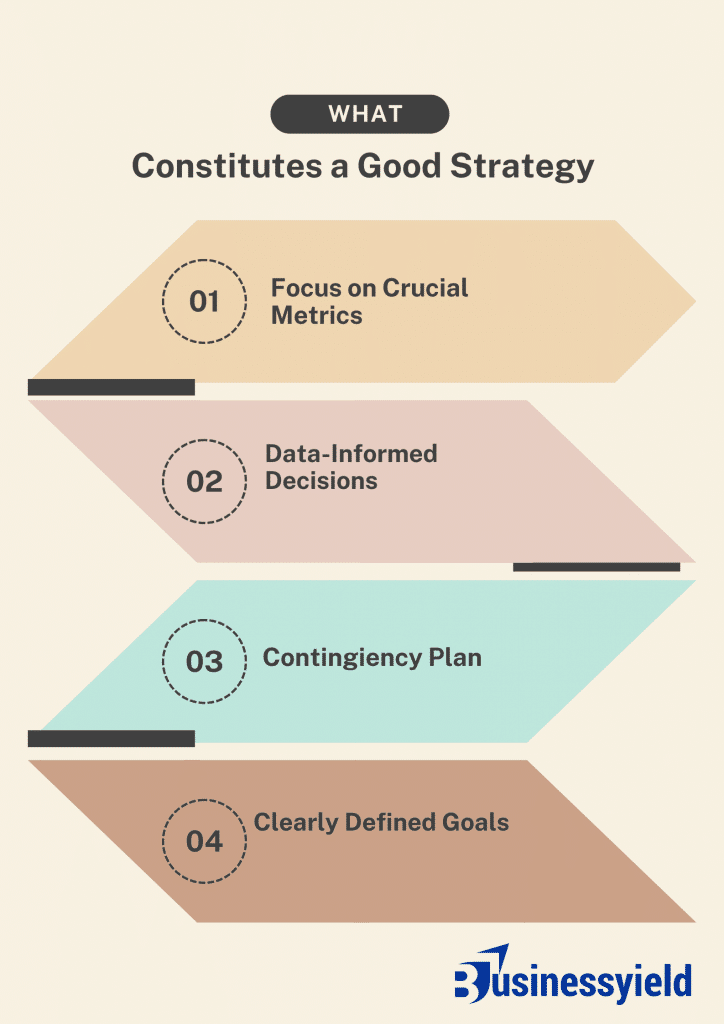As someone who writes about business, I’ve seen many companies struggle because they don’t separate their big-picture goals from their day-to-day actions. Not understanding the difference between strategy and tactics (strategic vs. tactical) can frustrate even the most ambitious plans.
Let me cite an example. I wrote about an up-and-coming tech company working on really advanced AI technology. Their big goal was to create AI that could transform multiple industries—an amazing vision. But it was a mess when I looked at how they actually operated. They were just coding away with no clear processes, priorities, or alignment. Their brilliant big-picture idea failed because of poor execution tactics.
The lesson? Having an impressive strategy means nothing without well-planned tactics to make it happen. It’s like saying you want to take an amazing vacation but never make any real plans for travel, hotels, etc. You’ll quickly get lost.
So, in this article, I’ll explain the key differences between strategy and tactics so you can put both pieces together correctly. You’ll learn how to connect your top-level goals with the specific, practical steps needed to turn that vision into real results.
Key points
- Tactics without strategy quickly evolve into useless work
- A good strategic plan solicits input from all levels of the company to ensure that the enterprise’s broad goal and the priorities of each department are aligned
- A great tactical approach should have a well-defined and unambiguous purpose that supports your strategy.
- Strategy and tactics are used in tandem to achieve a goal
Strategic vs. Tactical: The Difference
When it comes to strategic implementation, you’ve most likely heard people in your firm debate both strategic and tactical. These are typical terms that are frequently used in internet articles and at work. However, they are frequently misunderstood. Let’s get the record right about the difference. As mentioned earlier in this article, not understanding the difference between strategy and tactics (strategic vs. tactical) can frustrate even the most ambitious plans.
There are significant variations between strategic and tactical planning. In a nutshell, strategic planning determines the destination and how you will get there, whereas tactical planning explains the exact actions you will take along the way. Below, I’ll go over the distinctions and similarities between tactical and strategic planning and how to track their progress.
#A. Definitions
The terms “strategic” and “tactical” originated in military language from Sun Tzu’s The Art of War. Since then, they’ve been customized to meet a variety of contexts beyond military use, including commercial strategy.
Definition of Strategic
A strategic plan is a future action plan to help you attain a specific end objective. Strategies help you identify your long-term goals and how you plan to achieve them.
What makes a good strategy?
Based on the illustration I made:
A solid strategy represents the organization’s underlying beliefs. Your strategic team should solicit feedback from across the business to ensure that the strategy and the priorities of each department are aligned. Every strategy should be actionable.
I remember when I needed to develop a good plan, my concentration was on the desired outcome (the objective). Your strategy is the foundation for all actions within the organization, and how it is developed will drive decision-making as your teams work to reach those objectives. For example, if a furniture company wants to increase its market share, one strategy could be offering the most competitive prices and constantly having common goods available. Leadership teams will make decisions that favor cost reduction.
Definition of Tactical
While strategic is the action plan that will lead you to your desired destination, tactical is the specific steps and acts that will bring you there. In a business environment, this refers to the specific actions teams take to accomplish the strategy’s objectives.
What constitutes a good tactic?
A tactical strategy serves a specific goal that supports your strategy. It has a set timeframe in which particular tasks will be done and their effects measured.
Let me also use this illustration: A furniture manufacturer could assess manufacturing processes to reduce waste and inefficiencies, lowering costs and, consequently, customer prices. The corporation can determine the performance of the strategy by comparing its costs before and after the analysis.
#B. The Connection
If someone tries to achieve their goals simply through strategy, they will not succeed since tactics are the specific action items that bring you where you need to go. When a team relies solely on strategy, they will only be preparing to achieve goals rather than carrying out the necessary tasks.
So this means you cannot attain your business objectives solely through techniques. Tactics without strategy quickly devolve into useless work. When this occurs, people are simply executing arbitrary activities with no strategic goal in mind. In the short run, team members may perceive this as busy work. In the long run, it might result in frustration, burnout, and job discontent.
Let’s look at the benefits of both strategic and tactical:
#C. Benefits
Strategic Planning
I found that strategic planning’s most significant advantage is that it allows firms to proactively prepare for and address challenges as they develop, putting the enterprise in an advantageous position.
This long-term perspective enables firms to:
#1. Shift Your Organization from Reactive to Proactive
Strategic plans enable your firm to foresee potential events and plan accordingly. This also allows your organization to take the required safeguards to avoid adverse situations. If disruptions occur, your company is better equipped to handle them.
#2. Create Clear Direction and Alignment around the Enterprise’s Objectives and Ambitions
A strategic plan gives the entire organization something to work toward. It enables CEOs to manage resources efficiently and make sound business judgments. Using both strategic and tactical planning aligns teams and gives personnel a long- and short-term vision.
#3. Implement Stronger Decision-Making
Strategic planning can be used to support or enhance decision-making by leveraging data and varied points of view recorded while teams work toward achieving strategic goals.
#4. Measure and Enhance Performance
Giving employees a purpose or goal to work toward can help enhance satisfaction and retention. By routinely checking on target progress, employees may easily see how their performance is progressing or where additional effort is needed.
#5. Manage Expectations and Build Employee Trust
Strategic planning promotes organizational transparency. This improves trust among employees and eliminates ambiguity.
Tactical Planning
A tactical plan facilitates the execution of strategic planning across the company. It helps to align teams, improve cross-team collaboration and communication, and raise employee engagement. Additional benefits of tactical planning include:
#1. Making it Easier to Achieve Corporate Objectives
You can achieve strategic goals by breaking down the overall picture into smaller, more detailed ones. This ensures that everyone understands who is doing what and when it needs to be done.
#2. Improving Employee Engagement and Performance
In this aspect, I can tell you that when utilized jointly, strategic and tactical planning give employees a clear grasp of their roles and duties. This makes employees feel more engaged and motivated to produce their best jobs.
#3. Focusing Team Efforts
A detailed tactical plan focuses teams on fulfilling goals and objectives that support the company’s mission and vision.
#4. Promoting Transparency
If there is any uncertainty regarding who is doing what, your strategy plan is unlikely to be successful. Implementing tactical strategies encourages staff to be organized and prepared.
#5. Creating Tangible Goals
High-level goals can be intimidating to employees; tactical planning makes them more digestible and actionable. With a defined strategy in place, teams have a clear route forward and know exactly what activities to take to achieve strategic goals.
#D. How Strategic Vs. Tactical Interact
Here are some examples of how strategic and tactical interact, which can help you distinguish between the two:
- Strategy is developed through significant research, planning, and internal reflection.
It is a long-term vision, whereas tactics are short-term activities. For example, if your marketing strategy is to increase your social media influence and performance, your tactics could be to identify the best channels for your brand and the most effective messages for your target audiences. Strategies can evolve to adapt to new internal or external circumstances in a business, but they should not be taken lightly.
- Tactics May Change Depending on the Effectiveness of Your Approach
Adjusting tactics to course-correct is far easier than overhauling your strategy, so make sure your strategic preparation is comprehensive.
- Strategy and tactics are used in tandem to achieve a goal.
For example, if you want to climb a mountain, one important part of your strategy may be to pick which side of the mountain to climb. Your methods would include the gear you’d purchase, who you’d bring with you, your entire trip itinerary, how long it would take to get there, what season you’d visit, and so on. A strategy without tactics will never be implemented or help you reach your objectives.
- Strategy and tactics must always be consistent with each other
You may be enamored with a specific project (i.e., a tactic), but it is only worthwhile if it is consistent with your long-term strategy. As a result, your strategy should determine which methods your business will implement or fund.
- Even the best strategies and tactics cannot cover everything.
Because resources are limited, selecting the correct strategy and tactics ensures that your efforts are focused on accomplishing your goal in the most efficient way possible.
#E. What they Cover
What Constitutes Good Strategy?

A good strategy has specific characteristics that contribute to its efficacy in guiding decision-making and ensuring long-term success.
A good strategy must address the following basic elements:
#1. Focus on Crucial Metrics
An effective strategy involves examining important indicators and pertinent data to get insights into the organization’s performance and market dynamics. A good strategy focuses on these critical indicators to identify areas for improvement and align activities to obtain optimal results.
#2. Data-Informed Decisions
A solid strategy is carefully thought out, planned, and thoroughly researched. I can tell you that if you want to develop a robust, long-term strategy, you need to collect knowledge and data from previous experiences to educate your future data-driven decision-making process.
For example, certain sectors in my company encounter seasonality. Knowing how to take advantage of seasonality exemplifies smart strategic thinking and the utilization of past data.
#3. Contingency Plans
From my experience, the success of your approach is dependent on an expected outcome. But what happens if your strategy fails? Here’s where a backup plan comes in. You can plan for speed bumps if you include a contingency plan in your strategy. Your team will know how to overcome the speed bump and prevent the project from derailing.
#4. Clearly Defined Goals
The finest tactics are based on well-defined goals. It is much easier to develop a strong strategy when you know exactly what you want to achieve. Long-term strategic planning requires clearly defined goals. For example, I’ll always design my strategy and business goals simultaneously, which can help speed up the process. However, if there is no ultimate goal, developing a plan is like running a race without knowing the route.
What Constitutes Good Tactics?
Good tactics are critical to the success of your strategy since they are the particular activities that will help you achieve your objectives. They oversee the implementation and execution of actions that support larger goals and objectives.
Good tactics should:
#1. Align with Strategic Goals
Effective tactics are intimately related to the organization’s strategic goals. They support the overall strategy direction and directly contribute to meeting the strategic objectives. When tactics are well aligned with the overall strategy, you can be confident that every action taken propels the organization toward the key metrics outlined in your strategic plan.
If you’re having trouble understanding how a particular method fits into your strategy, it may not be the appropriate tactic for you. Your effort should actively contribute to your desired outcomes.
The goal-setting framework OKRs are an excellent example of how short-term methods can relate to a long-term vision. There is one major purpose, and you set critical results to achieve it. The techniques that people use regularly help to grow important results.
#3. Be actionable and time-restricted.
Tactics are most effective when applied within a short time frame. Like other goal-setting procedures, implementing time-bound deadlines guarantees that tactics are accomplished within a specific time range.
#4. Be Short-term
If a strategy is a long-term plan, a tactical action plan consists of short-term actions that assist you in achieving smaller goals. Tactical planning is breaking down your overarching strategy into shorter-term tasks.
Now, what are examples of strategic vs. tactical planning?
Checkout our Strategic vs Tactical Checklist
#F. Examples of Strategic Vs. Tactical
To further clarify the notion, consider a few examples.
#1. Local Government
Accountability and responsiveness are essential components of excellent municipal government. As a result, you may have a long-term goal of increasing transparency.
- Your strategy: To reach that goal, you decide to upgrade your communication strategy by establishing and implementing new two-way communication channels. This will not only help you understand what people want and need, but it will also allow you to keep them updated.
Your tactical: You could use the following tactics to achieve that goal:
- Create and launch a new community dashboard to keep locals informed about government goals and report progress.
- Create a marketing strategy that promotes how citizens can interact and communicate with the government.
- Schedule virtual town hall meetings regularly. To guarantee inclusivity, consider recording these discussions and making them available for later viewing, along with summary notes and important takeaways.
- These tactics have a fixed deadline and, if completed, will ultimately contribute to achieving the overall goal.
#2. Education
Standardized test scores show that the majority of school systems are constantly working to improve learning outcomes. There are several ways and approaches you might use to complete that assignment.
Incorporating technology in the classroom can boost student engagement and improve learning outcomes.
Your tactics: Some techniques you may use to achieve that strategy include:
- Purchase and install SMART systems in your classrooms for the coming school year.
- Provide instructors with professional development opportunities to help them make the greatest use of SMART technology and improve their teaching.
- Add gamified learning platforms or educational apps to the curriculum to make learning more dynamic and interesting for students. This strategy not only boosts student engagement but also fosters a more individualized learning experience that accommodates diverse learning styles and paces.
- These tactics have a clear purpose that will help the strategy and a set deadline. Once completed, they will help you get closer to attaining your strategy.
#3. Healthcare
Many healthcare organizations face a common dilemma in terms of hospital capacity: the demand for patient beds exceeds the availability. With the overriding aim of enhancing the health of the population you serve, this is a problem that must be addressed.
To enhance patient flow and free up beds faster, your solution is to improve internal systems rather than building new beds due to limited land.
Your tactics: To achieve that objective, you might employ the following tactics:
- Implement a scheduling app to improve OR efficiency and get patients through the flow more rapidly.
- Invest in a data analytics system to gain a better understanding of capacity limits and future predictive analytics applications.
- Implement a telemedicine program for post-operative and follow-up treatment, allowing patients to have virtual consultations with healthcare providers remotely, saving time and resources for both the patient and the hospital. This strategy can be especially beneficial for patients with mobility issues or who reside far away.
- These strategies will assist in identifying bottlenecks in your existing processes and providing data that can be used to make better decisions, all of which will ideally unlock additional capacity within the resources that are already available.
Now, let’s discuss ways you can make the most of strategic vs. tactical plans.
#G. Making the Most of Your Strategic vs. Tactical Plans
To maximize the benefits of both types of planning, your company should adhere to the best practices outlined below.
#1. Effective Strategic Planning
Typically, an organization’s strategy mirrors its mission and vision. The strategic plan aims to add value to the firm by focusing on goals that the enterprise considers important to attain.
Your plan should be actionable and focused on the goal you want to attain.
A good strategic plan solicits input from all levels of the company to ensure that the enterprise’s broad goal and the priorities of each department are aligned. This is why we should view strategic and tactical planning as complementary rather than opposing notions.
#2. Effective Tactical Planning
A great tactical approach should have a well-defined and unambiguous purpose that supports your strategy. It should include a comprehensive timeframe for completing specified actions, how their effects will be measured, and the resources required to fulfil the tasks.
The execution of these tasks should be thoroughly planned, including timelines and who is responsible for the effort.
What is the Difference Between Strategic and Tactical?
While strategic planning considers long-term goals and objectives, tactical planning focuses on the day-to-day actions required to fulfil the strategic plan’s aims. The technique includes defining comprehensive schedules, assigning resources, and detailing particular steps.
What is the Difference Between a Tactician and a Strategist?
Strategists set the course, while tacticians navigate the unexpected. To a brilliant strategist, the future should never be unexpected. They conduct in-depth analyses of industry trends and market forces to anticipate their competitors’ activities. They strive to outfight them before they realize they’re fighting.
What is an example of strategic vs. Tactical?
It is a long-term vision, whereas tactics are short-term activities. For example, if your marketing strategy is to increase your social media influence and performance, your tactics could be to identify the best channels for your brand and the most effective messages for your target audiences.
Which Comes First Strategic or Tactical?
Strategic comes first. Once you’ve developed your strategic plan, you must decide on the tactics you’ll utilize to achieve your objectives. This is where the tactical plan comes into action. It explains the measures that a company or individual will need to follow to achieve the goals that have been established.
How do You go from Tactical to Strategic?
Having been through developing a plan myself, here are pointers to assist you in your shift from a tactical thinker to a strategic leader:
- Delegate the small stuff.
- Set some time for strategic planning.
- To improve your strategic leadership, consider elevating your staff
- Evaluating strategic issues, developing a plan
- Demonstrating good leadership traits.
Why is it Vital not to Jump into Tactical Work before Developing a Strategy?
If you do not make the effort to develop a plan, you risk spending time and money on ineffective techniques since you are simply guessing what will work. Taking the time to develop a marketing strategy and a tactical implementation plan upfront will ensure that your budget is spent efficiently.
Conclusion
The tactical counterpart offers the measures necessary to achieve the strategic goals, but the strategic goals offer a distinct, overarching approach. A strategic and tactical plan work together to guarantee your business’s long-term success.
- What Is Strategic Financial Management?- Functions and Importance
- Mastering the Art of Strategic Leadership: A Comprehensive Guide to Developing Essential Skills for Success
- BUSINESS MANAGEMENT: Definition and Introduction Business Management Degrees
- Asset Allocation: Beginner’s Guide to the Investing Strategies (+Examples)
- Mastering Business with Strategies from Hearts and Other Card Games






